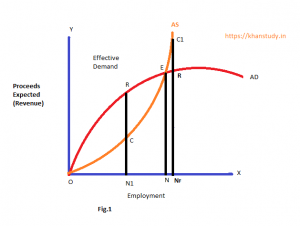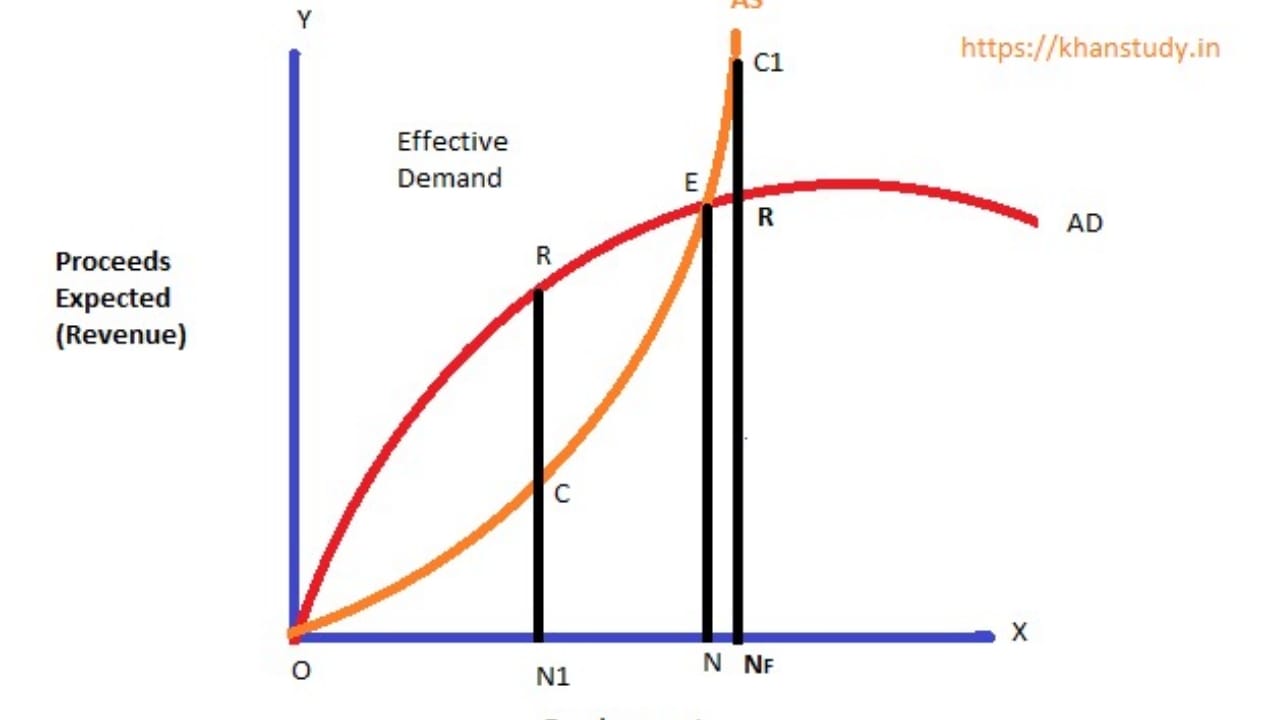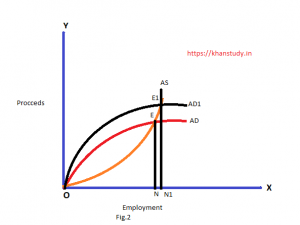Hello Friends, welcome to my website Khan Study. In today’s article we are going to know about Keynesian Theory of Employment (Effective demand, Aggregate demand, aggregate supply). So let’s discuss this.
Table of Contents
Effective Demand
The logical starting point of Keynesian theory of employment is the principle of effective demand. In a capitalist economy, the level of employment depends on effective demand. Demand becomes effective when income is spent in buying consumption goods and investment goods.
Keynes used the term effective demand to denote the total demand for goods and services at various levels of employment. According to him, the level of employment is determined by effective demand which in turn is determined by aggregate demand price and aggregate supply price.
Aggregate Demand Price
The aggregate demand price for the output of any given amount of employment is the total sum of money or proceeds, which is expected from the sale of the output produced when that amount of labour is employed. Thus the aggregate demand price is the amount of money which the entrepreneurs expect to get by selling the output produced by the number of men employed.
In other words, it refers to the expected revenue from the sale of output produced at a particular level of employment. Different aggregate demand prices relate to different levels of employment in the economy. According Keynes, the aggregate demand function is an increasing function of the level of employment and is expressed as D = F (AO, where D is the proceeds which entrepreneurs expect from the employment of N men.
Aggregate demand function slopes, upward from left to right because as the level of employment increases aggregate demand price also rises, shown AD curve in Figure 1.
Aggregate Supply Price
When an entrepreneur gives employment to certain amount of labour it requires certain quantities of co-operant factors like land, capital, raw materials, etc. which will be paid remuneration along with labour. Thus each level of employment involves certain money costs of production including normal profits which the entrepreneur must over.
The aggregate supply price refers to the proceeds necessary from the sale of output at a particular level of employment. Thus each level of employment in the economy is related to a particular aggregate supply price and there are different aggregate supply prices for different levels of employment.
According to Keynes, the aggregate supply function is an increasing function of the level of employment and is expressed as Z = N, where Z is aggregate supply price of the output from employing N men.
Aggregate supply function slopes upward from left to right because as the necessary expected proceeds increase, the level of employment also rises. But when the economy reaches the level of full employment. the aggregate supply curve becomes vertical.
Determination of Effective Demand
The level of employment is determined at the point where the aggregate demand price equals the aggregate supply price. This point is called the effective demand and here entrepreneurs earn normal profits. Figure 1 illustrates the determination of effective demand where AD is the aggregate demand function and AS is the aggregate supply function.
The horizontal axis we measures the level of employment in the economy and the vertical axis the proceeds expected (revenue) and the proceeds necessary costs. T he two curves AD and AS intersect each other at point E. This is effective demand where ON workers are employed.
At this point, the entrepreneurs expectations of profits are maximised. At any point other than this, the entrepreneurs will either incur losses or earn subnormal profits. Following diagram shown Keynesian theory of determination.

It is, therefore, the aggregate demand function which plays a Vital role in determining the level of employment in the economy. According to Keynes, the aggregate demand function depends on the consumption function and investment function. The level of employment can be raised by increasing either consumption expenditure or investment expenditure, or both.
If ONF is the level of full employment for the economy. It requires the raising of the point of effective demand. This is possible by raising the aggregate demand curve to AD1 where it intersects aggregate supply curve AS at E1.
This is the hew point of effective demand which provides an optimum level of employment to the economy. If the aggregate demand function is raised beyond this point the economy will experience inflation because all the existing resources are fully employed and their supply can not be increased during the short run, as is apparent from the vertical portion of the AS curve in Figure 2.
Conclusion
So friends, this was Keynesian Theory of Employment. Hope you get the full details about it and hope you like this article.
If you like this article, share it with your friends and turn on the website Bell icon, so don’t miss any articles in the near future. Because we are bringing you such helpful articles every day. If you have any doubt about this article, you can comment us. Thank You!
Read More Article
• Economic Ideas of Dadabhai Naoroji | Dadabhai Naoroji Drain Theory



